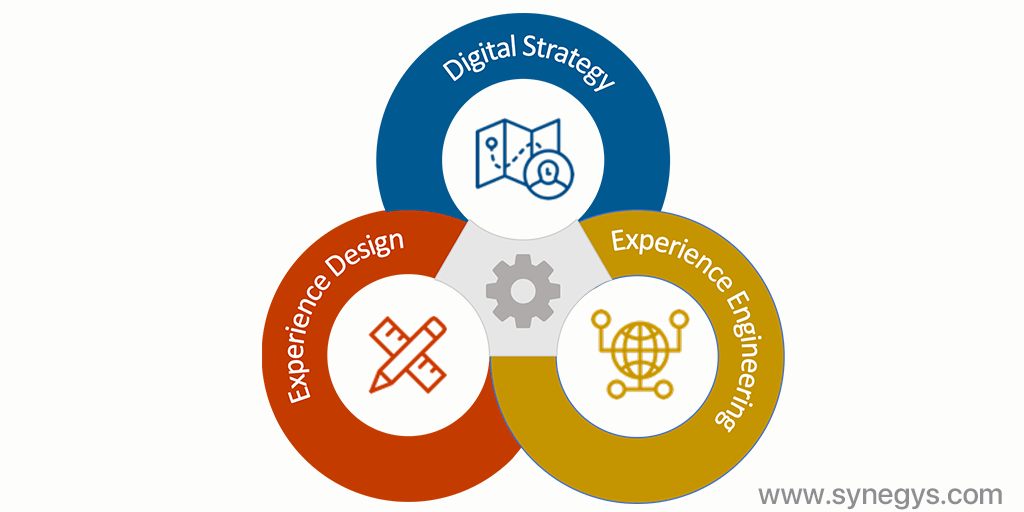Customer Experience Mapping, Design and Engineering
Customer journeys are a powerful tool for businesses to focus on customer centricity. However, many businesses fail in execution. Researchers found that 93% of companies fail to implement customer journeys successfully.1 Improving the customer journey requires businesses to go through three stages: 1. Mapping & Planning; 2. Experience Design; and 3. Solution Delivery. In this article and accompanying video, we briefly describe what needs to be done to improve touchpoints along the customer journey.
1. Mapping & Planning: Understand the Customer Experience
Businesses need to understand how they can use digital touchpoints to engage with customers. In fact, digital-first companies are 64% more likely to achieve their business goals than their peers.2
A Customer Journey Map (also known as “user journey” or “buyer journey”) tells the story of your customers’ experiences with your business or brand. Customers go through several behavioural stages as they interact with your brand through touchpoints. For each touchpoint, it is important to understand the expectations, thoughts and experiences of customers. Based on how well expectations are met, improvement opportunities and insights are generated to improve the customer experience.
2. Experience Design: Optimise the Customer Journey
A customer journey map is used to understand consumers’ buying dynamics, identify their key needs and behaviours, and provide insights to providing engaging content at each interaction touchpoint. Building on these insights, activities performed in this stage may include: identifying desired touchpoints and improving usability to existing ones, adding and/or improving engaging content at each touchpoint, designing business processes & workflows, modelling process data flows and understanding switching (e.g. from mobile device to desktop to social media).
Once initiatives are defined and a plan is developed, clear governance and KPIs need to be in place, costs need to be transformed into quantifiable business cases and priorities need to be set.
3. Solution Delivery: Implement New and Improve Existing Touchpoints
Once prioritization is done and improvements are linked to financial benefits, businesses are often challenged to realize the initiatives. They realize that there is more to customer journeys than colourful post-it notes, fancy diagrams and creative workshops. Working solutions need to be implemented.
Technology resources should be familiar and comfortable with the activities outlined in the previous two stages. Expect many iterations with the Experience Design Stage as business requirements and functional specifications of a working technology solution is defined. Solutions often involve frontend web and mobile development, process integration, cross-platform development & support, systems integration and hosting & maintenance.
With a touchpoint solution in place, journeys need to be integrated into the daily business. Traditional organizational structures need to give way to journey governance supported by clear KPIs.
Quickly Achieve Results with our Digital Service Blueprints
DXpaths, a division within Synegys, offers Digital Service Blueprints to help businesses design superior customer experiences. The blueprints offer best practice, benchmarks, processes and workflows, surveys and methodologies. Blueprints are available for different industry sectors including retail, restaurants, entertainment, banking, utility industries among others. Moreover, these blueprints drive the delivery of an integrated, digital touchpoint solution ranging from social media, online advertisement, digital marketing content, product catalogs, ecommerce, product reviews, emails, customer support channels, customer onboarding, product fulfilment, customer loyalty programs, and self-service resources among others. Solutions are accessible via mobile apps, text messaging, web apps or any other digital technology.
Execute – Tie Customer Journey Mapping to Operational Changes
Achieving customer centricity involves three stages: Planning and mapping of the customer journey, experience design, and experience engineering. Understanding how customers interact with each touchpoint along their journey allows you to design better customer experiences. Having defined the requirements outlining key touchpoints, a functional solution can be developed and rolled out. Journeys then need to be integrated into the daily business where traditional organizational structures give way to journey governance via clear KPIs.
Once all of this is achieved, businesses are well positioned to receive greater customer loyalty, realize more revenue and achieve higher returns.


